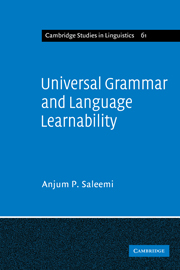Book contents
- Frontmatter
- Contents
- Preface
- 1 The problem of language learnability
- 2 The components of the linguistic system
- 3 The components of the learning system
- 4 Approaches to parameter fixation
- 5 The scope and limits of the current approaches
- 6 The distribution and variety of null subjects
- 7 Augmented parameter fixation: pro subjects and learnability
- 8 Review and integration
- Notes
- References
- Index
3 - The components of the learning system
Published online by Cambridge University Press: 04 August 2010
- Frontmatter
- Contents
- Preface
- 1 The problem of language learnability
- 2 The components of the linguistic system
- 3 The components of the learning system
- 4 Approaches to parameter fixation
- 5 The scope and limits of the current approaches
- 6 The distribution and variety of null subjects
- 7 Augmented parameter fixation: pro subjects and learnability
- 8 Review and integration
- Notes
- References
- Index
Summary
Having outlined the patterns of interaction between UG and the learning theory, and described the essentials of the former, it may be beneficial now to begin to establish the basis of a systematic theory of language acquisition. The following pages, consequently, are intended to lay down the groundwork of such a theory.
Foundations of the learning theory
The primary goal of the learning theory is to study every component of the phenomenon of language learning methodically, e.g. the learner, the nature of the input data, the object of learning, etc. To this end we informally adopt the concept of a learning paradigm from Osherson, Stob and Weinstein (1984, 1986a). We now introduce this concept, which will be employed throughout as the overarching framework for the discussion of various aspects of learnability.
A learning paradigm includes, to begin with, some explicit characterization of what is learned: e.g. the grammar of the language to be learned, described in accordance with a viable theory of natural language. Further, it contains a view of how something is learned (i.e. a set of learning mechanisms), by whom (i.e. information about the nature of the learner), and under what conditions (i.e. some specific view of the nature and complexity of the experience required as input to the learning system). In short, we adapt the following definition of a learning paradigm from Osherson et al.
- Type
- Chapter
- Information
- Universal Grammar and Language Learnability , pp. 30 - 56Publisher: Cambridge University PressPrint publication year: 1992



